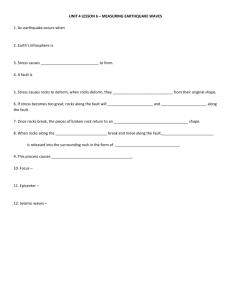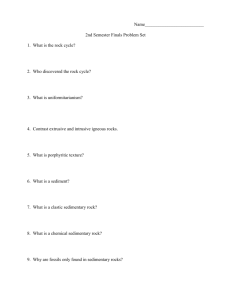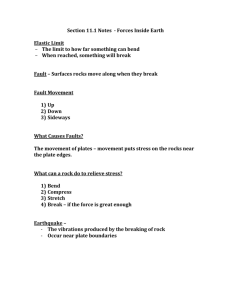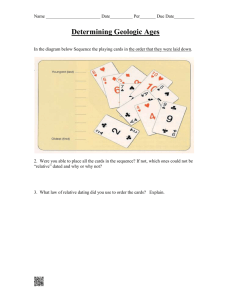Geol 101: Physical Geology Fall 2003
advertisement
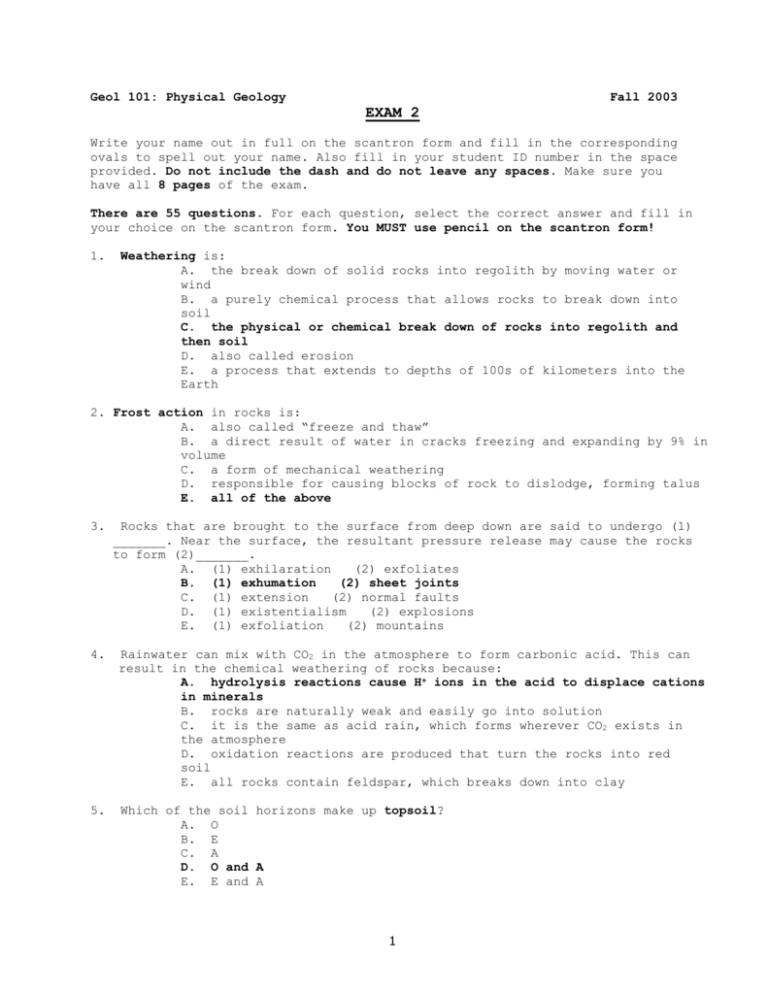
Geol 101: Physical Geology Fall 2003 EXAM 2 Write your name out in full on the scantron form and fill in the corresponding ovals to spell out your name. Also fill in your student ID number in the space provided. Do not include the dash and do not leave any spaces. Make sure you have all 8 pages of the exam. There are 55 questions. For each question, select the correct answer and fill in your choice on the scantron form. You MUST use pencil on the scantron form! 1. Weathering is: A. the break down of solid rocks into regolith by moving water or wind B. a purely chemical process that allows rocks to break down into soil C. the physical or chemical break down of rocks into regolith and then soil D. also called erosion E. a process that extends to depths of 100s of kilometers into the Earth 2. Frost action in rocks is: A. also called “freeze and thaw” B. a direct result of water in cracks freezing and expanding by 9% in volume C. a form of mechanical weathering D. responsible for causing blocks of rock to dislodge, forming talus E. all of the above 3. Rocks that are brought to the surface from deep down are said to undergo (1) _______. Near the surface, the resultant pressure release may cause the rocks to form (2)_______. A. (1) exhilaration (2) exfoliates B. (1) exhumation (2) sheet joints C. (1) extension (2) normal faults D. (1) existentialism (2) explosions E. (1) exfoliation (2) mountains 4. Rainwater can mix with CO2 in the atmosphere to form carbonic acid. This can result in the chemical weathering of rocks because: A. hydrolysis reactions cause H+ ions in the acid to displace cations in minerals B. rocks are naturally weak and easily go into solution C. it is the same as acid rain, which forms wherever CO2 exists in the atmosphere D. oxidation reactions are produced that turn the rocks into red soil E. all rocks contain feldspar, which breaks down into clay 5. Which of the soil horizons make up topsoil? A. O B. E C. A D. O and A E. E and A 1 6. Which of the following is NOT a type of soil? A. loess B. pedirites C. laterites D. pedalfers E. pedocals 7. How much of A. B. C. D. E. 8. the Earth’s crust is made up of sedimentary rocks? 95% 75% 50% 25% 5% A short break in time during sediment deposition, or a small change in the sedimentary facies, results in the creation of a/an: A. unconformity B. angular unconformity C. bedding plane D. disconformity E. nonconformity 9. Which type of sediment consists of broken down particles of rocks produced by weathering and erosion? A. detrital B. clastic C. chemical D. any of the above E. A and B above 10. Match up the sediment type with the corresponding correct rock name: A. sand conglomerate B. silt mudstone C. clay arkose D. sand greywacke E. mud chert 11. A typical is that they: A. B. C. D. E. feature of the sediment particles in glacially-produced tillite are are are are are poorly sorted and angular poorly sorted and well rounded well sorted and angular well sorted and well rounded typically found in the region of the Great Lakes 12. Which of the following minerals is NOT commonly produced by evaporation of seawater? A. halite B. limestone (it’s not a mineral!) C. gypsum D. calcite E. all of the above minerals can form by evaporation 13. Which of the following rocks cannot possibly have formed as a biogenic sedimentary rock? A. limestone 2 B. C. D. E. 14. chalk chert rock salt coal Which of the following sedimentary structures is common in sand dunes? A. cross-bedding B. trace fossils C. graded bedding D. mudcracks E. all of the above 15. Which of the following descriptions is not correct when talking about graded bedding? A. small sediment grains are at the bottom and large grains are at the top B. a gradual change in sediment size throughout a bed C. often associated with turbidity currents on ocean slopes D. a gravitational effect produced when sediment drops out of flowing water E. it can be formed on a river bed during floods 16. Which of the following changes in a depositional environment will NOT cause a change in the appearance of the resultant sediment that gets deposited? A. change from an oxidizing to a reducing environment B. rise or fall in sea level C. advance or retreat of glacial ice D. rivers changing their course through time E. all of the above will cause changes in the sediment appearance 17. The zone of metamorphism is above the zone of (1)________ but below the zone of (2)_________. A. (1) diagenesis (2) partial melting B. (1) magma (2) migmatites C. (1) 150ºC (2) 800ºC (I allowed this one too) D. (1) partial melting (2) diagenesis E. (1) molten magma (2) partial melting 18. Which of the following descriptions of lithostatic pressure is correct? A. it is caused by the weight of the overlying rocks B. it is equal in magnitude from all directions C. it causes rocks to decrease in volume but it does not change the rock shape D. all of the above E. none of the above 19. Which of the following will have no effect on the process of metamorphism? A. the addition of water to the rocks being metamorphosed B. the length of time of metamorphism C. the type of rock that got metamorphosed D. the pressures and temperatures that the rocks experienced E. all of the above will have an impact on metamorphism 3 20. 21. 22. 23. 24. is: If two different types of rocks get metamorphosed at exactly the same temperatures and pressures as each other, then: A. the index minerals will be the same as the rocks get metamorphosed B. the mineral assemblages will be identical C. the metamorphic grade is the same in each case D. the resultant metamorphic rocks will be identical E. none of the above In A. B. C. stratigraphy, the principle of stratigraphic superposition states that: all sedimentary beds start off being horizontal all sedimentary beds are separated by bedding planes a sedimentary bed is older than the bed above it and younger than the bed below it D. a sedimentary bed is younger than the bed above it and older than the bed below it E. a sedimentary bed must be older than any feature that cuts through it or disrupts it The presence of multiple species in the fossil assemblage of a sedimentary rock may help us narrow down the age of the rock because: A. we know the exact age of all types of fossils B. certain species only co-existed for limited periods of geologic time C. evolution prevents rocks with different ages from having the same types of fossils D. fossil assemblages can be used to correlate rock layers from place to place E. fossils contain radioactive elements that can be used to determine the age A sedimentary bed contains three fossils: A, B, and C. Fossil A formed from an animal that only existed in the Ordovician and Silurian Periods. Fossil B existed from the Silurian through to the Permian Period. Fossil C existed for a very long time on Earth- from the Cambrian to the Triassic Period. Based on this fossil assemblage, what must the age of the rock be? A. Cambrian B. Ordovician C. Silurian D. sometime between the Cambrian and the Triassic is all that we can tell E. it’s impossible to tell The correct order of the geologic time divisions, from longest to shortest, A. B. C. D. E. 25. epochs, periods, eras, eons epochs, eons, periods, eras eons, eras, periods, epochs eras, periods, epochs, eons eons, epochs, eras, periods About 66 million years ago… A. a giant meteorite collided with the Earth B. all the dinosaurs went extinct C. the Tertiary Period began D. the Paleocene Epoch began 4 E. 26. The process of beta decay is when: A. an atom releases a pair of protons and a pair of the nucleus B. an atom releases a proton and a neutron from the C. an atom releases an electron from the nucleus as into a proton D. an atom releases a pair of protons and a pair of the nucleus E. an atom gives off gamma rays and generates a lot 27. An isotope (2) _____: A. B. C. D. E. 28. 29. 30. 31. all of the above neutrons from nucleus a neutron turns electrons from of heat that undergoes decay starts off as a/an (1) _____ and becomes a (1) (1) (1) (1) (1) alpha particle (2) beta particle daughter (2) son daughter (2) parent parent (2) daughter parent (2) mutant If the half-life of an isotope is 1 million years, and 200 of these isotope atoms get trapped in a crystal in an igneous rock when it first forms, how old will the rock be when there are only 25 of these isotopes left in the crystal? A. 1 million years old B. 2 million years old C. 3 million years old D. 4 million years old E. 5 million years old Stress is the same as: A. force B. pressure C. strain D. force divided by area E. pressure divided by volume If a rock deforms when it experiences a stress, but then returns to its original shape when the stress is removed, then the deformation behavior is described as: A. plastic B. elastic C. ductile D. brittle E. magical The tensional stress that formed a joint: A. was oriented parallel to the orientation of the joint B. was oriented perpendicular to the orientation of the joint C. was oriented obliquely to the orientation of the joint D. cannot be determined from the joint orientation E. was produced by the cooling of basalt lava 32. Faults are most common at the boundaries between tectonic plates, such as in the: A. New Madrid region of Missouri B. East African Rift Valley 5 C. D. E. 33. 34. 35. 36. If a fault (1) _______ A. B. C. D. E. circum-Pacific belt all of the above none of the above plane is dipping, the block of rock above the fault plane is the and the block below the fault plane is the (2) __________. (1) footwall (2) hanging wall (1) footwall (2) fault scarp (1) fault scarp (2) footwall (1) hanging wall (2) fault scarp (1) hanging wall (2) footwall When a fault slips, the (1) ________ moves up and the (2) ________ moves down: A. (1) hanging wall (2) footwall B. (1) footwall (2) hanging wall C. (1) fault block (2) fault plane D. (1) fault scarp (2) fault plane E. the answer depends on the type of fault Most normal faults have a dip of (1)_____; most reverse faults have a dip of (2)_____; and most strike-slip faults have a dip of (3)_____. A. (1) 60º (2) 30º (3) 90º B. (1) 60º (2) 90º (3) 30º C. (1) 30º (2) 60º (3) 90º D. (1) 30º (2) 90º (3) 60º E. (1) 90º (2) 60º (3) 30º A graben, or rift valley, will only form in response to slip along: A. normal faults B. reverse faults C. thrust faults D. strike-slip faults E. any type of fault, as long as one side moves down 37. Along the San Andreas fault, the east side is moving towards the south and the west side is moving towards the north. This makes the San Andreas fault a _______ fault: A. normal B. right-lateral C. left-lateral D. reverse E. it depends on what side of the fault you are standing on 38. In a/an (1)______ the rock layers warp upwards in the middle, which causes the (2)______ rocks to be exposed at the center of the fold at the surface of the Earth. A. (1) syncline (2) youngest B. (1) syncline (2) oldest C. (1) anticline (2) youngest D. (1) anticline (2) oldest E. (1) plunging fold (2) deepest 39. In order for an earthquake to occur.... A. a differential stress is needed B. stored elastic energy must be released C. the frictional strength of a fault must be overcome 6 D. E. all of the above only B and C above 40. The largest earthquake ever felt in the continental United States during historical times was: A. in southern Alaska in 1964 B. in San Francisco in 1906 C. in New Madrid, Missouri during the winter of 1811-1812 D. in Charleston, South Carolina in 1886 E. off the coast of Chile in 1960 41. Which of the following US earthquakes had the greatest magnitude? A. New Madrid, 1811-1812 B. San Francisco, 1906 C. Southern Alaska, 1964 D. Fort Tejon, 1857 E. Pacific Northwest, 1700 42. The epicenter of an earthquake is: A. the location along a fault where the earthquake rupture starts B. the point from which body waves radiate into the surrounding rocks C. the point on the Earth's surface directly above the earthquake focus D. exactly the same as the focus of an earthquake E. sometimes at the Earth's surface, but not always 43. The order of arrival of seismic waves is: A. body waves, primary waves, surface waves, secondary waves B. P-waves, primary waves, S-waves, secondary waves C. P-waves, S-waves, Love waves, Rayleigh waves D. Love waves, primary waves, surface waves, Rayleigh waves E. Rayleigh waves, secondary waves, primary waves, Love waves 44. The type of seismic wave that has the same characteristics as sound waves is the: A. body wave B. surface wave C. S-wave D. Love wave E. P-wave 45. Three seismograph stations are needed to find the epicenter of an earthquake because: A. the more, the better B. at least one of the stations could have made a mistake C. some instruments cannot measure the P-S time interval D. more than three stations takes too long to process the seismogram data E. three distance measurements are needed to define a point on a map 46. The largest earthquake ever recorded was the 1960 Chile earthquake, which was measured to be a M9.5 on the __________ scale. A. modified Mercalli 7 B. C. D. E. moment magnitude Richter intensity logarithmic 47. The intensity of an earthquake measured at some distance from the epicenter: A. is variable depending on the distance to the epicenter B. doesn’t change for an earthquake, no matter how far away it was C. is measured using the moment magnitude scale D. will be the same for all earthquakes with an identical magnitude E. none of the above 48. The intensity of the 2001 Nisqually earthquake (M6.8) near Seattle was far less than that of the 1994 Northridge earthquake (M6.7) near Los Angeles because: A. Seattle is not as heavily populated as Los Angeles B. Los Angeles has earthquakes more often C. buildings in Seattle are designed better than those in Los Angeles D. the focus of the Nisqually earthquake was much deeper than at Northridge E. Seattle is closer to the water, which absorbed a lot of the seismic waves 49. Loose, unconsolidated sediments are not good for buildings because: A. ground shaking is greater in these sediments B. seismic wave amplitudes increase in loose sediments C. liquefaction of the sediments is likely if they are saturated with water D. all of the above E. it’s best to build buildings on unconsolidated sediment, so none of the above 50. Which of the following is an accurate definition of the term tsunami? A. it is a type of earthquake that occurs under the ocean B. it is a type of seismic wave that causes a lot of damage to tall buildings C. it is a water wave generated in the ocean as a result of an earthquake D. it is a type of landslide triggered in a mountainous region during an earthquake E. it is the ancient Japanese art of calligraphy BONUS QUESTIONS 51. A good way A. B. C. D. E. to by by by by by tell if a detrital sedimentary rock has silt in it is: putting hydrochloric acid on it to see if it fizzes licking it chewing rubbing it gently across your teeth seeing if it sticks to your tongue 8 52. What type of sedimentary rocks formed when the Mediterranean Sea evaporated during the Pliocene epoch? A. detrital B. chemical C. biochemical D. biogenic E. clastic 53. The Pliocene epoch was followed by the ________ epoch, when the Mediterranean filled up again, and an ice age began. A. Holocene B. Paleocene C. Pleistocene D. Oligocene E. Tertiary 54. If you are in a swimming pool during an earthquake, the only body wave you will feel is the: A. P-wave B. S-wave C. Love wave D. Rayleigh wave E. you won’t feel the earthquake at all 55. For those people who actually showed up to class on Friday, October 10th, the answer is: A. Iceland B. bright green C. very salty D. volatile when wet E. Jenny from the block 9
